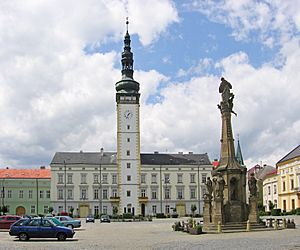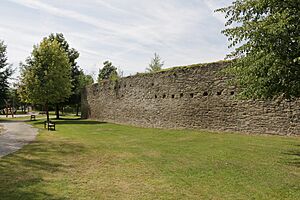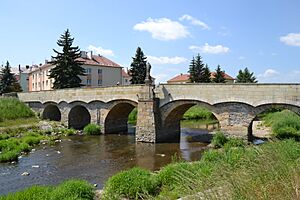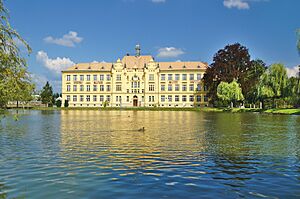Litovel facts for kids
Quick facts for kids
Litovel
|
|||
|---|---|---|---|
|
Town
|
|||

Přemysl Otakar II. Square
|
|||
|
|||
| Country | |||
| Region | Olomouc | ||
| District | Olomouc | ||
| First mentioned | 1287 | ||
| Area | |||
| • Total | 46.40 km2 (17.92 sq mi) | ||
| Elevation | 233 m (764 ft) | ||
| Population
(2024-01-01)
|
|||
| • Total | 9,689 | ||
| • Density | 208.81/km2 (540.83/sq mi) | ||
| Time zone | UTC+1 (CET) | ||
| • Summer (DST) | UTC+2 (CEST) | ||
| Postal code |
784 01
|
||
Litovel is a cool town in the Olomouc District of the Czech Republic. It has about 9,700 people living there. The old part of the town is very well kept. It is even protected by law as a special "urban monument zone."
Contents
Parts of Litovel
Litovel is made up of several smaller villages. These include Březové, Chudobín, Myslechovice, Nasobůrky, Nová Ves, Rozvadovice, Savín, Tři Dvory, Unčovice, and Víska. They are all part of the Litovel area.
Geography: Where is Litovel?
Litovel is located about 16 kilometers (10 miles) northwest of Olomouc. It sits in a flat area with lots of farms. This area is called the Upper Morava Valley lowland.
The highest point nearby is a hill called Šumina, which is 418 meters (1,371 feet) high. The Morava River flows right through the town. Six smaller branches of the river also run through Litovel. Because of all these waterways, Litovel is often called "Moravian Venice!"
Part of the town's northern area is in the Litovelské Pomoraví Protected Landscape Area. This special nature area is named after the town itself.
History: Litovel Through Time
The first time Litovel was officially mentioned in writing was in 1287. King Ottokar II founded the town between 1252 and 1256.
In 1327, King John of Bohemia gave the town permission to build strong walls. Litovel grew and became important until the Hussite Wars. After these wars, the town asked for protection. It came under the care of the Vlašim family from Úsov.
Later, in the 16th century, the lords of Boskovice took over the Úsov area. Litovel became their property and lost its special status as a "royal town."
In the early 1600s, the House of Liechtenstein gained control of Litovel. The town then became less important. The Thirty Years' War also hurt Litovel a lot. The Swedish army looted the town. There were also many outbreaks of the plague.
In 1850, Litovel became a district town. It started to grow as more people moved in from nearby areas. The Czech population became larger than the German population. Litovel became a center for Czech culture and learning. In the early 1900s, trade and factories grew quickly. New factories were built to process farm products.
Population: How Many People Live Here?
| Historical population | ||||||||||||||||||||||||||||||||||||||||||||||||||||||||
|---|---|---|---|---|---|---|---|---|---|---|---|---|---|---|---|---|---|---|---|---|---|---|---|---|---|---|---|---|---|---|---|---|---|---|---|---|---|---|---|---|---|---|---|---|---|---|---|---|---|---|---|---|---|---|---|---|
|
|
|
||||||||||||||||||||||||||||||||||||||||||||||||||||||
| Source: Censuses | ||||||||||||||||||||||||||||||||||||||||||||||||||||||||
Litovel has seen its population change over the years. In 1869, about 6,254 people lived here. By 1980, the population grew to over 10,000. Today, it has about 9,700 residents.
Economy: What Does Litovel Make?
Litovel is famous for its food industry. In the village of Tři Dvory, there is a factory called Adriana that makes pasta. There is also Brazzale, a company that makes cheese. It has one of the biggest hard-cheese factories in the world!
Litovel is also well-known for its brewery. People have been making beer here since 1297.
Another interesting thing made in Litovel is audio equipment. Pro-Ject brand turntables and other sound gear are made right here.
Transport: Getting Around Litovel
The D35 motorway passes through Litovel. This road connects Olomouc to the Hradec Králové Region. It is also part of a larger European road, the European route E442.
Litovel is also on a railway line that goes from Prostějov to Červenka. The town has three train stations. These are Litovel, Litovel město, and Litovel předměstí.
Sights: What to See in Litovel
The historic center of Litovel is around Přemysl Otakar II. Square. This area was once surrounded by the Morava River and its branches. It also had town walls, and you can still see parts of them today.
The main building on the town square is the town hall. It used to be a large house. The town bought it in 1557. It was rebuilt in 1572 and changed again in 1724. The town hall tower is 65 meters (213 feet) tall. It was built right over the Nečíz, which is one of the Morava River branches that flows under the square!
Old houses line the town square. In the middle of the square stands a plague column. It was built in 1724. The column has seven statues of saints who protected people from the plague. The Holy Virgin statue is at the very top.
The Bridge of Saint John (in Czech, Svatojánský most) is a stone bridge over the Morava River. It was built in 1592. This makes it the third oldest bridge in the Czech Republic. It is also the oldest stone bridge in Moravia.
The Gymnasium of Jan Opletal is another important building. This school building was built in 1901. It has four cool ceramic pictures designed by Jano Köhler. These pictures show scenes from the town's history.
The Church of Saints Philip and James is probably the oldest church in Litovel. It was first mentioned in 1342. It was completely rebuilt in a Baroque style between 1692 and 1694.
The Church of Saint Mark was also first mentioned in 1342. It was originally a Gothic church. It was largely rebuilt between 1529 and 1532. After the Thirty Years' War, it was changed again in the Baroque style.
Famous People from Litovel
Many interesting people have connections to Litovel:
- Gustav Tschermak von Seysenegg (1836–1927), an Austrian expert on minerals.
- Karl Kostersitz von Marenhorst (1839–1897), an Austro-Hungarian general.
- Marija Ružička Strozzi (1850–1937), a Croatian actress.
- Hans Temple (1857–1931), a Czech-Austrian painter.
- Gustav Frištenský (1879–1957), a very strong man and wrestler who lived and died here.
- Henry Kulka (1900–1971), a Czech-New Zealander architect.
- Jan Čep (1902–1974), a Czech writer and translator.
- Přemysl Krbec (1940–2021), a gymnast.
Twin Towns: Friends Around the World
Litovel has "twin towns" or "sister cities." This means they have special friendly relationships with these places:
 Littau (Lucerne), Switzerland
Littau (Lucerne), Switzerland Revúca, Slovakia
Revúca, Slovakia Wieliczka, Poland
Wieliczka, Poland
See also
 In Spanish: Litovel para niños
In Spanish: Litovel para niños







